The fuzz effect, which is based on a non-linear distortion of the guitar sound, is unquestionably one of the brightest and wildest guitar effects. The fuzz effect is also one of the sharpest and the most expressive among all the non-linear sound effects which adds some extra dirt into your guitar’s tone. Previously, it was reached by supplying a very high signal level to the amplifier’s input but nowadays, the best fuzz pedal can give you the opportunity to get so many different types of fuzz that no one could imagine years ago.
The fuzz effect belongs to the oldest guitar effects. It has firstly appeared due to the attempts to get the “overloaded” sound on the guitar’s amp. The absence of noise during pause and insensitivity to the low-level interference are among the biggest advantages of the good fuzz pedals. Most pedal sounds are comparable to the noise of a chainsaw, yet without it, classic 60s songs would be difficult to conceive.
The fuzz effect was firstly used by Marty Robbins in his “Don’t Worry” song. It also can be heard in Jimi Hendrix compositions. Nowadays, the fuzz effect is most frequently used by Jack White and Muse.
If you succeed in finding the best fuzz pedal, you will be able to improve the way you play guitar and add some creativity to your music. All you need to do is make the proper choice. However, there are too many models of such pedals presented on the market which may confuse even the experienced musician who already owns many guitar pedals. For this reason, our top picks are aimed to narrow down your choices. Plus, we have gathered some useful information that will be useful for making the proper decision in our buyer’s guide.
Fuzz Pedal Reviews
JHS Mini Foot
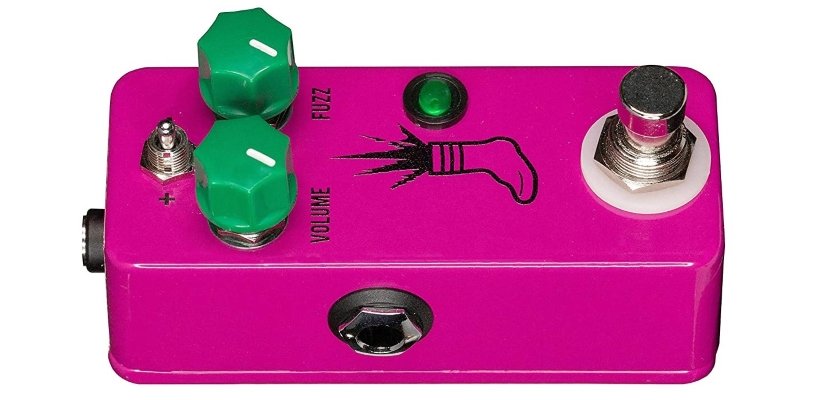
JHS has created a tiny fuzz pedal that measures 3.6 x 1.5 x 1 inches and is small enough to fit on an overloaded pedalboard. It produces a clean, traditional silicon fuzz sound with huge headroom and rich harmonics. The pedal features quite an outstanding, toy-like appearance with bright purple housing and green knobs.
There are only two controls on the pedal and a high/low gain toggle. Thanks to the Volume knob, you can get a low-gain vintage-style fuzz. The Fuzz control allows for some splatty tones. The toggle gives the opportunity to choose between an old-school sound and a more modern, high-gain buzz. There are also a true bypass and a very bright LED indicator that glows green when the pedal is in operation. This way, if you are looking for a tiny but versatile fuzz, this model from JHS may turn out to be the best guitar fuzz pedal for some guitar players.
The Mini Foot is suitable for a wide range of musical styles, from classic rock to modern fusion. It is also suitable for bass guitar.
The pedal weighs half a pound. It’s powered by a standard 9V DC negative power and consumes only 3 mA.
Pros
- The pedal is multifunctional and can be used in various ways (you can use the XLR and 1/4 output simultaneously, for example).
- The Mini Foot provides a very open and uncompressed sound at low gain.
- Despite the size, it allows getting everything from gated fuzz to almost infinite sustaining fuzz.
Cons
- It’s quite easy to get a bad sound when using this pedal so you will have to adjust it a lot.
- It adds some noticeable, high-pitched noise when it’s engaged and even when it’s not engaged.
Video JHS Mini Foot
JHS Muffuletta
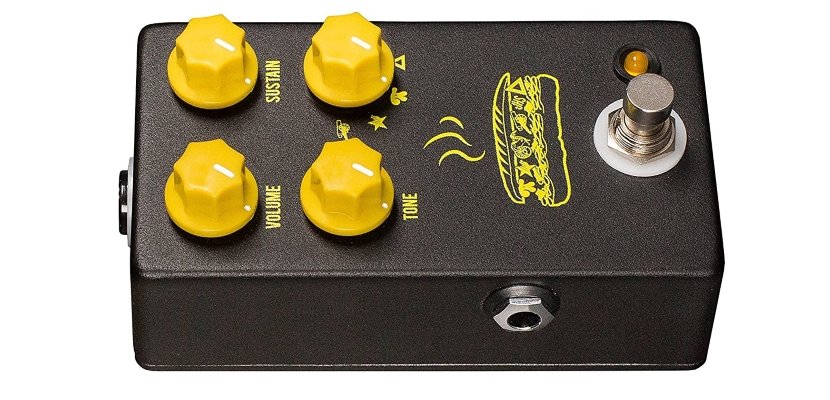
The Muffuletta from JHS is among the top fuzz pedals in terms of multifunctionality as it offers 6 different analog fuzz modes. The pedal is housed in a durable dark grey metal chassis and has 4 heptagon-shaped yellow knobs. There is also a bright yellow LED light that indicates whether the power is on or off. It has a pedalboard-friendly enclosure with its 2.2 x 4.8 x 1.6 inches and weighs a little more than half a pound.
The pedal has 4 controls and a true bypass. The Volume knob is designed to adjust the output volume of the pedal. The Tone knob works for adjusting the tone from brighter to darker. The Sustain knob allows controlling the amount of fuzz.
The Version Selector knob enables you to choose between 6 different settings. The Civil War mode provides more midrange and has a brighter overall tone with less gain (used by Sonic Youth, John Fogerty, Wilco, Mike Mills, REM). The Russian Muff mode gives less clarity and less low end being great for garage type of sound. The Pi mode gives a more aggressive sound. The Triangle Muff mode is more articulate and gives more low end response. The 73 Rams Head mode gives a scooped midrange, less gain, and overall darker tone. The JHS Muff is a classic, more powerful and less compressed mode, with a more haunting midrange, being the most suitable for bass guitars.
This pedal requires a standard 9V DC negative power and consumes approximately 100 mA.
Pros
- All of the knobs on the pedal are fairly large and easy to operate.
- Each one of the pedal modes stays fairly true to their sound.
- The helpful guide on how to properly use all of the multiple pedal’s functions is included in the package.
Cons
- It’s hard to get clean tones when using this pedal.
- The modes on the Version Selector knob are indicated with poorly understandable symbols which makes it confusing to use.
Video JHS Muffuletta
Zvex Effects Fat Factory
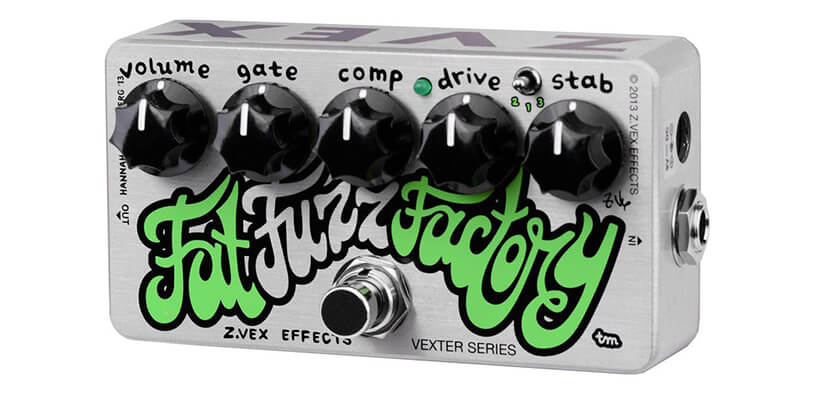
This model from Zvex is a germanium fuzz pedal used by some popular bands such as Nine Inch Nails and Deftones, for example. It’s also among the most multifunctional compact pedals on the market as it provides 5 control knobs, a three-way toggle switch to control the sub level (level 1. Original Fuzz Factory; level 2. Woof!; level 3. Look Out!), and true bypass to keep the signal unaffected. Thanks to the sub switch which provides a lot of bottom end, this unit may work as the best bass fuzz pedal for those who need more bassy tones.
The pedal goes in a grey housing with black knobs. Additionally, there is a green LED power indication. The pedal has 4.70 x 2.38 x 1.82 inches in size and weighs 0.58 lbs.
All of the 5 control knobs can be used for different operating levels and biases to form your individual fuzz. The Volume knob is designed to the output signal level. The Gate control muffles the noise after the end of the sustain, removes squeals, hissing, and buzzing. The Compression control adds attack characteristic which gets softer and enhances the tone when you turn the knob to right. The Drive control adjusts the pitch and the tonal thickness and can increase distortion when used as a usual fuzz. The Stability control is used for feedback pitch. It’s recommended to use this control below 2:00 if you like soft and squishy fuzz.
The pedal uses a 9V DC power supply with negative polarity on the middle pin. A 9V alkaline battery may also be used to power the pedal.
Pros
- The pedal’s user manual contains an example setting that you can use to achieve high-compression, velcro, radio, smooth fuzz, or cleanish high-octave intermodulation.
- The pedal is very low-current which extends the battery life.
- It doesn’t need to be adjusted constantly to get a stable tone.
Cons
- It’s not very convenient that the control knobs are located too close to each other.
- The incorrect settings on this pedal may lead to a very screeching sound.
- The pedal’s kit includes nor 9V DC power supply neither batteries.
Video Zvex Effects Fat Factory
Zvex Effects Fuzzolo
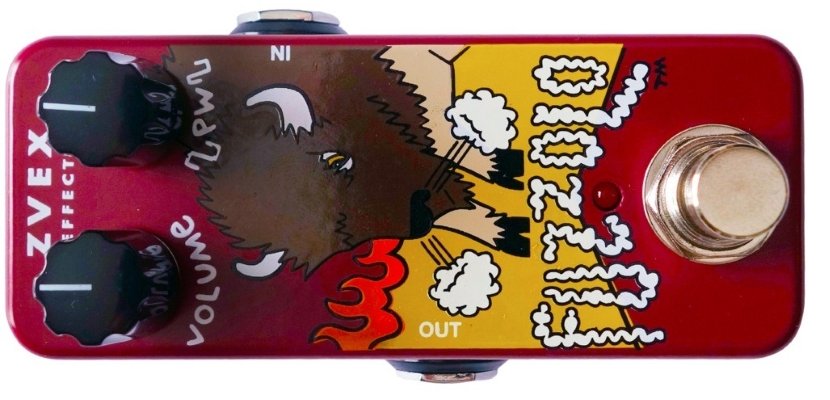
With 0.7 x 1.5 x 3.6 inches in size, this model from Zvex is even smaller than most of the other mini-sized pedals and will find space on any pedalboard. It works with guitars, but can also work as a bass fuzz pedal.
The device has a unique appearance, with a bright shiny red body and a furious bull portrayed in the middle. There are two control knobs located on the top panel of the unit. At the bottom of the pedal, you will find a red LED power indicator and a true bypass below it.
The manufacturer managed to put a great amount of fuzz in this tiny enclosure, so it sounds way louder than it looks (even despite having one of the simplest control schemes ever). It’s a silicon pedal that has a rich texture with the aggressive midrange and great volume. Use the Volume knob to change the volume output. The Pulse Width knob allows controlling the waveform and will let you go from square wave to a narrow/wide wave.
There is also a jumper on the pedal’s bottom lid: when moved to “P”, you can use the pedal with passive pickups on quieter instruments. Move it to “A” for usage with the active pickups.
The pedal is powered by 9V DC power supply (center negative) and weighs 0.33 lbs.
Pros
- The pedal is very responsive and responds to a little touch with lots of loudness.
- When a square-wave is fully installed, you can get a very pure fuzz.
- The Pulse Width control will allow you to achieve some nice hybrid tones.
Cons
- The red LED light is hard to notice on the pedal’s bright red body.
- Since there is no Tone knob, the Fuzzolo is a bit harsh on the top end.
Video Zvex Effects Fuzzolo
Wampler Velvet V2
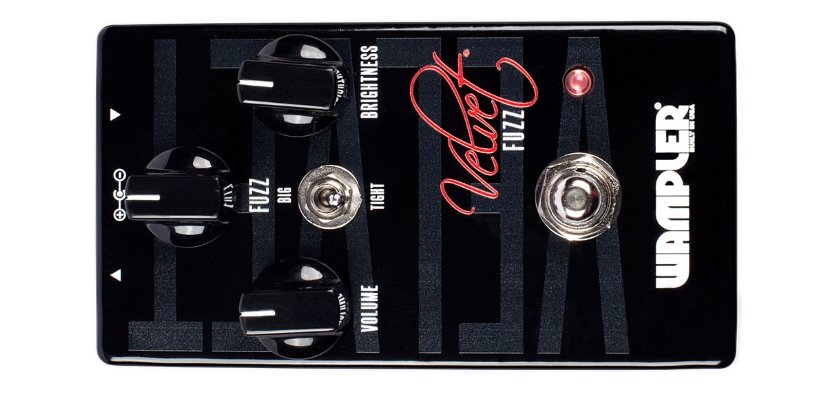
This guitar fuzz pedal from Wampler allows achieving many kinds of fuzz tones and features two completely different clipping options (pure fuzz and a distortion-like fuzz). It has a black housing with three vintage-styled control knobs, one toggle to switch between big/tight tone, and a bypass switch. As soon as the pedal is pressed, the LED indication becomes red.
The Volume control is designed for adjusting the output signal level of the pedal. It works similar to the volume knob on your guitar or your amplifier. It’s recommended to adjust the volume level in accordance with your Fuzz and Brightness adjustments.
The Fuzz control works for adjusting the amount of fuzz. The more you turn it clockwise, the more fuzz you get. The overall style of the fuzz also depends on this switch position.
The Brightness knob allows switching between darker, bassy sound (at the fully counterclockwise position) and a very highs-forward sound (when it’s fully clockwise). However, the most original sound can be achieved somewhere between these two extremes. You should also remember that this knob reacts differently depending on where the big/tight switch is.
The big/tight toggle switch changes the overall tone. With the switch in the “Big” position, you will get a thicker sound with some creamy fuzz. In the “Tight” position, the tone becomes tighter and feels a bit more distorted.
The pedal is 2.5 x 4.5 x 1.5 inches and weighs 1 lb. It features a top-mounted in/out jacks to easily fit on a pedalboard. Between these jacks, you can find a 9V DC power jack. Additionally, you can also use 9V batteries to power the device.
Pros
- The pedal is ideal for replicating David Gilmour’s and Eric Johnson’s signature tones.
- The true bypass switch is very soft.
- The pedal is handbuilt in the USA from the high-grade components picked specifically to ensure improved sound and response.
Cons
- Placing the pedal after a buffer may lead to significant changes in sound (especially if it’s switched to a “Big” position).
- It goes without any ample features.
Video Wampler Velvet V2
Zvex Effects Vexter Series
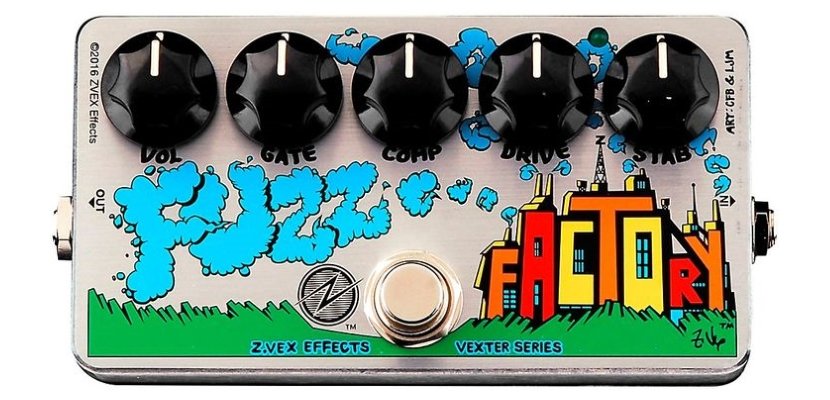
The Fuzz factory pedal from Zvex goes in a hand-silkscreened, hand-polished aluminum chassis with heptagon-shaped control knobs and bright hand-painted cartoonish design. It is 4.70 x 2.38 x 1.82 inches and weighs 0.4 lbs. The pedal also has a red LED light that indicates the on/off status. This model features 2 stocks of germanium transistors that allow creating a true vintage fuzz.
The pedal has 5 control knobs that are extremely interactive, meaning that changing one setting affects the others. This can make an adjusting process quite messy and will definitely confuse the beginners, but it’s easy to get used to it. Plus, the manufacturer provides some sample settings in the user’s manual to help you get along with the pedal’s basic characteristics.
The Volume knob adjusts the level of the effect. The Gate control will enable you to eliminate any unwanted sounds produced by the pedal. The Compression control knob can act as an attack or add some softness to your tone. The Drive knob adjusts how much distortion will be added to your sound. The Stability knob controls the feedback pitch. The true bypass is also present.
You can use this pedal with a 9V battery or with any 9V pedal power supply.
Pros
- The battery is included in the kit and there is no need to buy it separately.
- The pedal’s current equals 3-4 mA which means that the battery won’t get drained for a long time.
- You can get a lot of white noise with this pedal which makes it a rock‘n’roll ready solution.
Cons
- The pedal sometimes creates some strange sound similar to a saxophone that went out of tune.
- The control knobs are hard to turn.
Video Zvex Effects Vexter Series
Donner Classics Octave
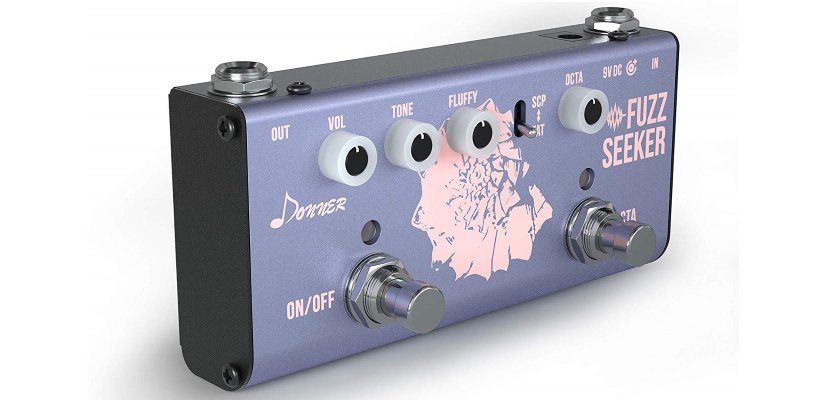
This Donner unit may be regarded a top fuzz pedal in terms of versatility, since it comes with many settings to fit any musical style. Besides, it’s also quite compact-sized (5.1 x 2.5 x 1.7 inches) and weighs only half a pound. It goes in a purple enclosure with knobs that feature a rubber grip and has rounded edges. It also features a true bypass and two green LED indicators that show the working on/off status and the upper octave overtone on/off status. It provides an aggressive fuzz with a wide tonal range which is suitable for both guitars and basses.
The two-way toggle lets you switch between two different kinds of fuzz sound for different types of music: the SCP mode gives you a more bright, scooped tone, and the FAT mode provides a thick, huge tone. The Octa control knob allows tuning the octave overtone amount (when you turn the Octa footswitch on) and adds the upper octave sounds.
There are also three standard control knobs: the Volume knob to control the output volume, the Tone knob which controls the effect tone, and the Fluffy knob to control the amount of fuzz gain.
This octave fuzz pedal requires a 9V DC center negative power supply and consumes 35 mA.
Pros
- The pedal features pure analog design and produces the classic 70s searing, squeezing fuzz sound.
- It provides an “Octavia” type of sound used by Jimi Hendrix and Roger Mayer.
- There is a noise cut-off point near the top of the Octa knob that reduces the background noises.
Cons
- The control knobs are difficult to operate because they are too tiny.
- The octave effect may seem too subtle to some users.
Video Donner Classics Octave
Donner Stylish
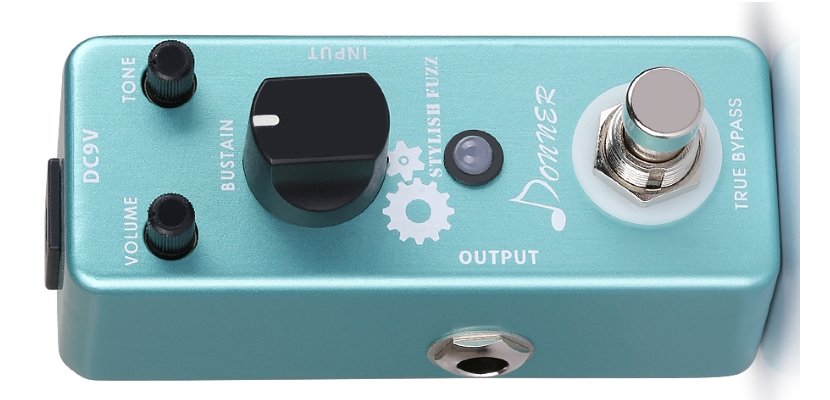
This model from Donner can possibly be the best cheap fuzz pedal among the mini-sized models as is features three control knobs despite its truly tiny size of 3.7 x 1.7 x 1.8 inches. It will even fit in your pocket if you need to take it with you everywhere. It works for traditional, rich fuzz effect and goes in an aluminum-alloy turquoise body. The pedal has a blue LED indicator to show the working state.
This pedal has a traditional set of control knobs. There are two tiny knobs: one for volume and the other for tone. The Volume knob allows controlling your guitar’s sound volume with fuzz effect. The Tone knob adjusts the depth of a fuzz tone. The Bustain (which is actually Sustain) knob is the largest one and is located in the center of the pedal’s top panel. Use to adjust the level of the fuzz sound. In addition, the pedal has a true bypass for a clear tone. Generally, the pedal’s sound can be compared to the violin tone as it sounds full and sweet.
Due to the size, the pedal can only be powered by a power adaptor. It requires a 9V DC power supply (negative in the center) and weighs 0.52 lbs.
Pros
- The pedal creates a good-sounding fuzz with minimal adjustments.
- The volume level is surprisingly powerful as for a mini-sized model.
- The interface is easy to use and understand, especially for beginners.
Cons
- The pedal can produce some noise when cranked up to the maximum.
- The pedal loses the sound accuracy with extreme settings.
Video Donner Stylish
Electro-Harmonix Deluxe Big Muff
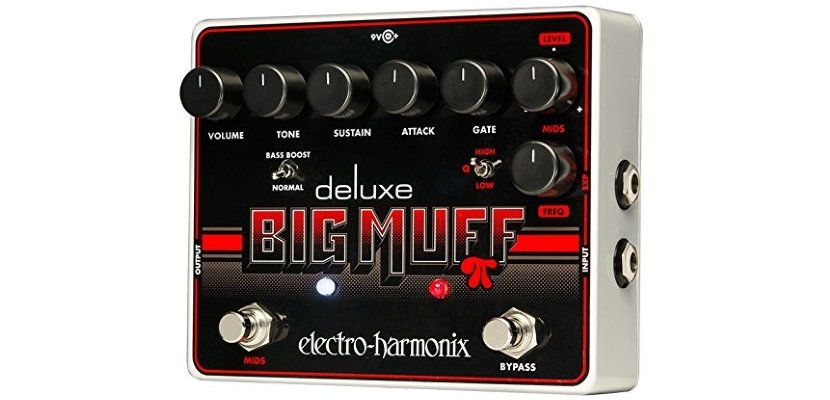
With 7 control knobs, this Electro-Harmonix model is very big. This Big Muff fuzz pedal features some gothic-like design, with red’n’black enclosure. There are two LED indicators to show the MIDS and the power statuses. The pedal is 3.5 x 7 x 8 inches and weighs almost 2 pounds.
The pedal features a MIDS section which includes four controls (indicated with red writings) that work for midrange adjustment. The MIDS Frequency knob sets the MIDS EQ circuit ranging from 310Hz to 5.0 kHz. The MIDS Level knob boosts or cuts up to +/- 10dB. The MIDS high/low switch sets the resonance or bandwidth of the MIDS EQ.
All the rest controls are standard. The Volume knob for adjusting the sound level of the entire pedal, the Tone knob increases treble and decreases bass, the Sustain knob adjusts the amount of sustain and distortion, the Attack knob adjusts the Attack effect, the Gain knob controls buzzing and hum. There is also a bass boost/normal switch.
The pedal can be powered via a 9V battery, or via a 9VDC AC adapter capable of delivering at least 50 mA.
Pros
- The pedal provides similar to the original NYC Big Muff Pi pedal classic sound.
- The MIDS section is great for live performances as is it helps you cut through the other instruments.
- The MIDS section has its own bypass switch in addition to the normal bypass.
Cons
- The Attack control can add an unnecessary harshness to the sound.
- The noise gate release time is too short, resulting in sudden blackouts.
Video Electro-Harmonix Deluxe Big Muff
BOSS FZ-5
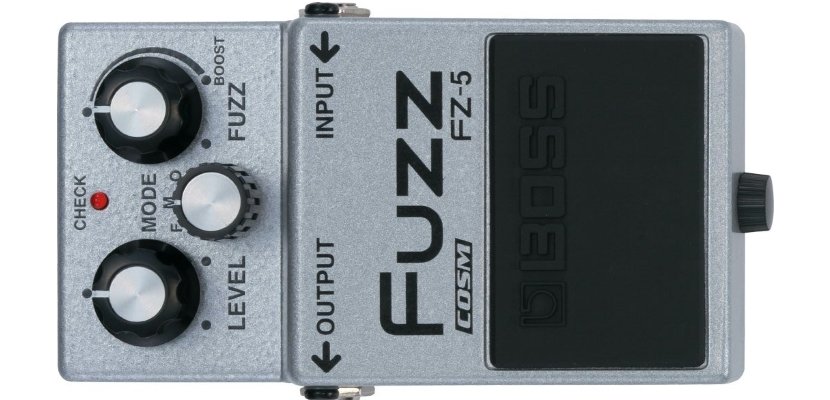
This Boss fuzz pedal has a very simple but robust road-tough metal construction. It features three control knobs. The Volume knob controls the volume of the fuzz effect. The Mode knob allows selecting from three modes which allow recreating the sound of famous fuzz pedals of the 60s and 70s. The M (Face) mode simulates the sound of the Fuzz Face pedal with its psychedelic thick fuzz. The M (MST Fuzz) mode works like Maestro FZ-1A (or like the pedals equipped with 2N2614 germanium transistors) providing a prominent boost in the high-frequency range. The O (Octave Fuzz) provides the octavia fuzz sound. The Fuzz knob controls the amount of fuzz effect applied.
The pedal can be powered via battery or with the help of an AC adaptor (PSA-series). It has 2.8 x 5 x 2.3 inches and weighs 1 lb (with battery). The pedal features a LED indicator which indicates the power status and goes dimmer when the battery is near exhaustion.
Pros
- There is a thumbscrew on the bottom part of the pedal which allows you to change the battery with ease.
- The FZ-5 uses an advanced COSM technology to recreate a classic fuzz.
- If you get tired of standard fuzz, just boost the fuzz knob to get an aggressive tone.
Cons
- When using an AC adaptor, the battery sometimes fails.
- It’s hard to find the right placement in the chain for this pedal to get the proper sound.
Video BOSS FZ-5
Buyer’s Guide
Transistor as the Main Factor to Consider Before Buying the Fuzz Pedal
When it comes to fuzz pedals, the transistors are used to create their circuit. Actually, the fuzz circuit is very simple, having only two main transistors. However, in some cases, they may differ from each other in a significant way.
Germanium fuzz
Nowadays, most transistors are made of silicon. However, throwing back to 1948, most of them were made of germanium. This material is actually similar to silicon, located on the same row of the periodic table. Plus, they both are semiconducting materials that are perfectly suitable for transistors manufacturing.
The germanium transistors were the first ones, and they were quite unstable because the formation of the transistor’s PN junctions requires a very accurate method which was impossible for the technologies of that time. Even barely noticeable differences can cause great changes in the transistor’s gain. Plus, the oxide formation is also important for most transistors, and in the case with germanium, it’s definitely not easy to form a stable oxide. This way, the germanium transistors appeared to be both unstable and difficult to manufacture. Additionally, they are very susceptible to temperature fluctuations, so it becomes clear why each transistor sounds in a different way.
However, why do transistors sound differently in the fuzz pedal circuit? The first reason is the difference between devices. The transistor’s gain, which is known as Beta, equals to current out/current in. Even despite the fact that the fuzz circuit helps compensate for Beta changes, this parameter is critical in determining the fuzz circuit’s overall gain. In the best fuzz pedals, the gain of each transistor should be within a certain value so the pedal sounded really pleasant.
Sometimes, the fuzz pedal has hand-picked transistors which means that they were specifically tested and selected for the improved sounding of the fuzz. However, the transistors in the Fuzz Face pedal, for example, weren’t specifically selected since it was mass-produced. That is why Fuzz Face pedals differ in sound.
The germanium transistors also have a lot of stray capacitance which means that the transistor can keep charge in areas that are not intended for this. Since it slows down the circuit’s voltage-time response, it also causes some changes in sound. When this happens on a fairly slow scale, the sound of a particular transistor will be different. This way, the sound of your guitar through the guitar pedal can be considered as a change in voltage level over time. The main change lies in the fact that the higher notes will be cut off more.
To conclude, there are two main issues with the germanium transistors. First, they are very variable and it is difficult to get two identical ones. Second, they have a lot of parasitic capacitance which affects the voltages that are in the musically audible range. Both of these issues negatively affect the fuzz pedal.
Silicon fuzz
With the advancement of technology, it became apparent that silicon transistors are less variable and simpler to manufacture. It also became possible to make silicon oxides directly on the wafer which helped develop the MOSFET.
The other important change was the way of doping the transistors (the addition of impurity atoms with an aim to endow the material with better or worse characteristics) which contributed to the development of the abrupt junctions. This way, the fuzz pedals with silicon transistors became more higher-gain devices. Since they also became more reliable, there are fewer variations in such important parameters as Beta. They are more alike so you probably won’t get a great range of values. This should eliminate the pedal’s variability.
Additionally, the parasitic capacitance became significantly smaller in this modern silicon transistors. That is why the devices work in higher frequencies since more treble comes through in a silicon fuzz pedal resulting in a brighter sound.
Generally, silicon transistors provide more gain and higher Beta than germanium ones which leads to the appearance of different types of fuzz and distortion.

Hi everyone! I’m Thomas Moody, also known as Guitarzan.
